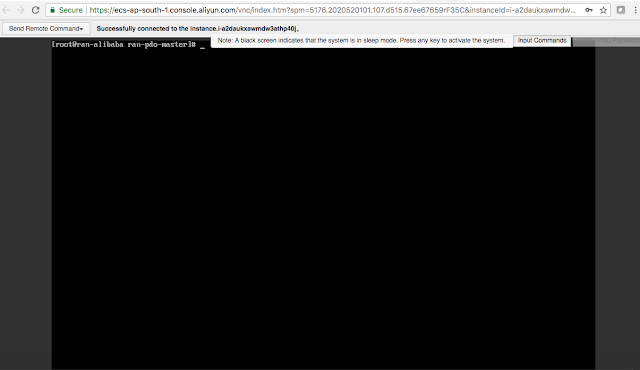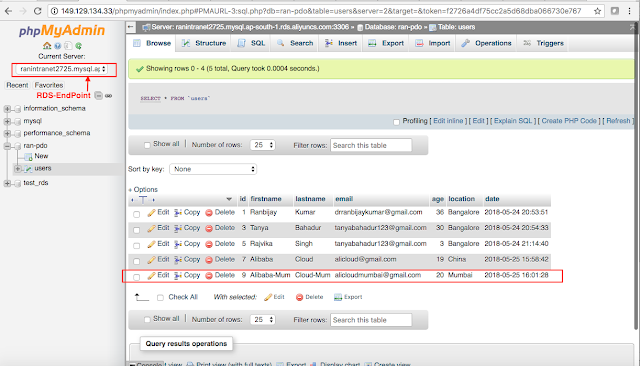Hi Reader, in this tutorial, we'll learn how to deploy web application sample to Alibaba cloud. Please be noted the minimum deployment are involve here of using one ECS and one RDS instance.
To deploy
web application on Alibaba cloud. I preferred to write a code in PHP language and built the CRUD
operation where front-end s/w tools are installed on ECS and backend database deployed
on RDS.
Following
are the referral useful links to deploy the web application and to test it
further as a pre-requisite:
Over
the ECS instance – to run the front-end part of the web application sample, I've installed/configured following software and tools over the CentOS system image:
Suggestion: For best
practice, it’s always recommended to execute and run the sample application at your
own environment first (i.e., local machine), before deploying it into the target
cloud services.
Before
starting of our hands-on exercise, let’s do first benchmark set-up for both ECS
and RDS services. During set-up process, users have a choice to opt either
‘subscription’ or ‘pay-as-go’ model depending on their needs.
I purchased super-high benchmark configuration for deployment
of the sample web application and doing further R&D exercise in future
assignment. The details are available below for reference:
1. Benchmarking of ECS
For ECS instance, from the offered list of System, Marketplace and
Custom Image, I preferred to go with CentOS system image for hands-on, as I am
more comfortable to Linux based environment rather than Windows. Also, I have
Mac machine for doing my personnel R&D or innovation for my personnel interest.
Product
Elastic Compute Service
Instance Name:
i-a2daukxawmdw3athp40j
Configuration Details
Instance: 2-core,
8GB Generation III Network Enhanced sn2ne
IO optimized instance: IO
optimized instance
System disk: /dev/xvda
Ultra Cloud Disk
Bandwidth: 5.0000Mbps
Data Transfer
CPU: 2Core
Available zone: Asia
Pacific SOU 1 Zone A
OS: CentOS
7.3 64bit
Mem: 8GB
Region: Asia
Pacific SOU 1 (Mumbai)
Network type: VPC
Manage service: Yes
After ECS instance get activated, the status of instance been
turned “Running” in status.
To test it further, how it works? Just clicked on “Connect” option
at the right side of the Instance list portal, it opens the “Management
console” for doing further exercise. Before getting the screen you need to
provide VNC connection
password. (Alert: The VNC connection password is viewable only once. Ensure
you record this password and keep it in a secure location for subsequent login
attempts.)
2. Benchmarking of RDS
Product
ApsaraDB for RDS
Instance Name:
rm-6gjgil677k1r6xs1r
Configuration Details
RDS Specifications: 1
Core, 1 GB
Database type: MySQL
Database version: 5.7
Internet traffic: cost
debited based on daily traffic usuage
Zone: Asia
Pacific SOU 1 Zone A
Node type: High-Availability
Edition
Region: Asia
Pacific SOU 1 (Mumbai)
Storage: 5GB
Network type: VPC
My current ApsaraDB for RDS Management portal looks like below
image. Before doing any exercise to make sure the status of instance should be
“Running”.
Since, I opted MySQL DB to use for my hands-on exercise. Related
to MySQL, quick start, set-up and configuration details are well documented and
available in Alibaba Cloud Document center for reference, helped me to do my
hands-on in an easy manner.
Set-up MySQL root database user account as below [Alert: Creating master account
activation will disappear account/database management from RDS instance portal,
once the master account gets activated. Best practice here to create first
database and account (ordinary one) and give privilege Read/Write to access
them]
Whitelist setting:
Other product also explored and used for
hands-on purpose, such as:
· Object Storage Service (to upload/download the sample web app)
· Cloud-Monitor Service
Steps
of Hands-on Exercise:
Step1: Installing
Apache, PHP 7.2 and MySQL on CentOS 7.4 System ECS Instance
1.
Note
In this exercise, I use the hostname/Public_IP address with the IP 149.129.134.33.
I will add
the EPEL repo here to install latest phpMyAdmin as follows:
[root@ran-alibaba /]# rpm --import
/etc/pki/rpm-gpg/RPM-GPG-KEY*
[root@ran-alibaba /]# yum -y install epel-release
To edit
files on the shell, I'll install the nano editor. If you prefer vi/vim for file
editing, then skip this step.
[root@ran-alibaba /]# yum -y install nano
2.
Installing MySQL / MariaDB
MariaDB is a
MySQL fork of the original MySQL developer Monty Widenius. MariaDB is
compatible with MySQL and I've chosen to use MariaDB here instead of MySQL. Run
this command to install MariaDB with yum:
[root@ran-alibaba /]# yum -y install mariadb-server
mariadb
Then we
create the system startup links for MySQL (so that MySQL starts automatically
whenever the system boots) and start the MySQL server:
[root@ran-alibaba /]# systemctl start mariadb.service
[root@ran-alibaba /]# systemctl enable mariadb.service
Set passwords
for the MySQL root account:
[root@ran-alibaba /]# mysql_secure_installation
[root@ran-alibaba /]# mysql_secure_installation
In order to
log into MariaDB to secure it, we'll need the current password for the root
user. If you've just installed MariaDB,
and you haven't set the root password yet, the password will be blank, so
you should just press enter here.
Enter current password for root (enter for none):
<--ENTER
Ok,
successfully used password, moving on...
Setting the
root password ensures that nobody can log into the MariaDB root user without
the proper authorization.
[root@ran-alibaba /]# Set root password? [Y/n]
New password: <--yourmariadbpassword
Re-enter new password: <--yourmariadbpassword
Password
updated successfully!
Reloading
privilege tables.
... Success!
By default,
a MariaDB installation has an anonymous user, allowing anyone to log into
MariaDB without having to have a user account created for him or her. This is intended only for testing, and to
make the installation go a bit smoother.
You should remove them before moving into a production environment.
Remove anonymous users? [Y/n] <--ENTER
... Success!
Normally,
root should only be allowed to connect from 'localhost'. This ensures that someone cannot guess at the
root password from the network.
Disallow root login remotely? [Y/n] <--ENTER
... Success!
By default,
MariaDB comes with a database named 'test' that anyone can access. This is also intended only for testing, and
should be removed before moving into a production environment.
Remove test database and access to it? [Y/n]
<--ENTER
- Dropping test database...
... Success!
- Removing privileges on test database...
... Success!
Reloading
the privilege tables will ensure that all changes made so far will take effect
immediately.
Reload privilege tables now? [Y/n] <--ENTER
... Success!
Cleaning
up...
All
done! If you've completed all of the
above steps, your MariaDB installation should now be secure.
Thanks for
using MariaDB!
[root@ran-alibaba /]#
3.
Installing Apache
CentOS 7
ships with Apache 2.4. Apache is directly available as a CentOS 7 package, therefore
we can install it like this:
[root@ran-alibaba /]# yum -y install httpd
Now
configure your system to start Apache at boot time...
[root@ran-alibaba /]# systemctl start httpd.service
[root@ran-alibaba /]# systemctl enable httpd.service
To be able
to access the web server from outside, we have to open the HTTP (80) and HTTPS
(443) ports in the firewall. The default firewall on CentOS is firewalld, which
can be configured with the firewalld-cmd command.
[root@ran-alibaba /]# firewall-cmd --permanent
--zone=public --add-service=http
[root@ran-alibaba /]# firewall-cmd --permanent
--zone=public --add-service=https
[root@ran-alibaba /]# firewall-cmd --reload
Now direct
your browser to the IP address of your server, in my case http://149.129.134.33/, and
you should see the Apache placeholder page:
4.
Installing PHP
The PHP
version that ships with CentOS as default is quite old (PHP 5.4). Therefore I
will show you in this exercise some options to install newer PHP versions like
PHP 7.0 or 7.1 from Remi repository.
Add the Remi
CentOS repository.
[root@ran-alibaba /]# rpm -Uvh
http://rpms.remirepo.net/enterprise/remi-release-7.rpm
[root@ran-alibaba /]# Install yum-utils as we need the
yum-config-manager utility.
[root@ran-alibaba /]# yum -y install yum-utils
and run yum
update
[root@ran-alibaba /]# yum update
Now you have
an option to choose which PHP version you want to use on the server. PHP
version at a time with Apache mod_php. To install PHP, run this command:
[root@ran-alibaba /]# yum -y install php
To Install
PHP 7.2, use:
[root@ran-alibaba /]# yum-config-manager --enable
remi-php72
[root@ran-alibaba /]# yum -y install php php-opcache
We must
restart Apache to apply the changes:
[root@ran-alibaba /]# systemctl restart httpd.service
5.
Testing PHP / Getting Details About Your PHP Installation
The document
root of the default website is /var/www/html. We will create a small PHP file
(info.php) in that directory and call it in a browser to test the PHP
installation. The file will display lots of useful details about our PHP
installation, such as the installed PHP version.
[root@ran-alibaba /]# nano /var/www/html/info.php [install nano editor on CentOS: yum -y
install nano]
In nano
editor, type following code and exit.
<?php
phpinfo();
To switch
from nano editor to root-command, in Mac OSX: press fn+F2. Now we call that file in a browser (e.g. http://149.129.134.33/info.php):
As you see,
PHP 7.2 is working, and it's working through the Apache 2.0 Handler, as shown
in the Server API line. If you scroll further down, you will see all modules
that are already enabled in PHP. MySQL is not listed there which means we don't
have MySQL support in PHP yet.
6.
Getting MySQL Support In PHP
To get MySQL
support in PHP, we can install the php-mysqlnd package. It's a good idea to install some other PHP
modules as well as you might need them for your applications. You can search
for available PHP5 modules like this:
[root@ran-alibaba /]# yum search php
Pick the
ones you need and install them like this:
[root@ran-alibaba /]# yum -y install php-mysqlnd
php-pdo
In the next
step I have installed some common PHP modules that are required by CMS Systems
like Wordpress, Joomla, and Drupal (for future exercise and learning):
[root@ran-alibaba /]# yum -y install php-gd php-ldap
php-odbc php-pear php-xml php-xmlrpc php-mbstring php-soap curl curl-devel
Now restart
Apache web server:
[root@ran-alibaba /]# systemctl restart httpd.service
Now reload http://149.129.134.33/info.php
in your browser and scroll down to the modules section again. You should now
find lots of new modules like curl etc. there:
If you don't
need the php info output anymore, then delete that file for security reasons.
[root@ran-alibaba /]# rm /var/www/html/info.php
7.
phpMyAdmin installation
phpMyAdmin
is a web interface through which you can manage your MySQL databases.
phpMyAdmin
can now be installed as follows:
[root@ran-alibaba /]# yum -y install phpMyAdmin
Now we
configure phpMyAdmin. We change the Apache configuration so that phpMyAdmin
allows connections not just from localhost (by commenting out the
<RequireAny> stanza and adding the 'Require all granted' line):
[root@ran-alibaba /]# nano
/etc/httpd/conf.d/phpMyAdmin.conf
Inside the
nano editor, the screens should be
[...]
Alias
/phpMyAdmin /usr/share/phpMyAdmin
Alias /phpmyadmin
/usr/share/phpMyAdmin
<Directory
/usr/share/phpMyAdmin/>
AddDefaultCharset UTF-8
<IfModule mod_authz_core.c>
# Apache 2.4
#
<RequireAny>
# Require ip
127.0.0.1
# Require ip
::1
#
</RequireAny>
Require all granted
</IfModule>
<IfModule !mod_authz_core.c>
# Apache 2.2
Order Deny,Allow
Deny from All
Allow from 127.0.0.1
Allow from ::1
</IfModule>
</Directory>
<Directory
/usr/share/phpMyAdmin/>
Options none
AllowOverride Limit
Require all granted
</Directory>
[...]
Next, we change the authentication in phpMyAdmin from
cookie to http:
[root@ran-alibaba
/]# nano /etc/phpMyAdmin/config.inc.php
[...]
$cfg['Servers'][$i]['auth_type'] = 'http'; // Authentication method (config, http or
cookie based)?
[...]
Restart Apache:
[root@ran-alibaba
/]# systemctl restart httpd.service
Step2: phpmyadmin_connect_to_rds [Tutorial on connecting your phpmyadmin to
an external Cloud RDS instance]
[root@ran-alibaba /]# nano
/etc/phpMyAdmin/config.inc.php
--ADD LINES
BELOW THE PMA CONFIG AREA AND FILL IN DETAILS--
$i++;
$cfg['Servers'][$i]['host'] = '<RDS-Endpoint>';
$cfg['Servers'][$i]['port'] = '3306';
$cfg['Servers'][$i]['socket'] = '';
$cfg['Servers'][$i]['connect_type'] = 'tcp';
$cfg['Servers'][$i]['extension'] = 'mysql';
$cfg['Servers'][$i]['compress'] = FALSE;
$cfg['Servers'][$i]['auth_type'] = 'config';
$cfg['Servers'][$i]['user'] = '<Username>';
$cfg['Servers'][$i]['password'] = '<Password>';
Step3:
Testing Web-Application URL:
Screen-shot
UI:
Backend:















